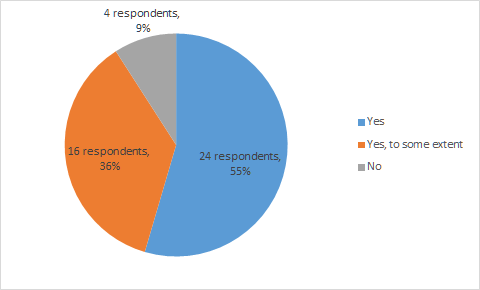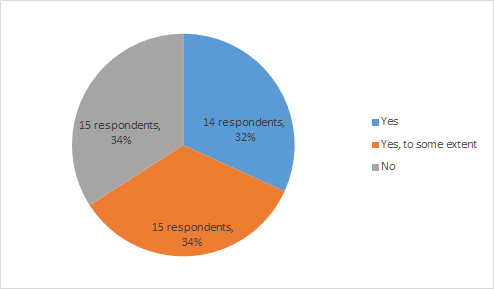Survey on key indicators of the Programme of Work of Article 23 of the Cartagena Protocol on Biosafety
Background
The Programme of Work on Public Awareness, Education and Participation concerning the safe transfer, handling and use of living modified organisms (2011-2015) (Programme of Work) was adopted by the Conference of the Parties service as the meeting of the Parties to the Cartagena Protocol on Biosafety (COP-MOP) in 2010 (decision BS-V/13). At its eighth meeting, in 2016, the COP-MOP took note of a report on the status of implementation of the Programme of Work and extended the Programme of Work until 2020 (decision CP-VIII/18).
The Programme of Work was developed to facilitate the implementation of Article 23 on public awareness, and participation. It contains four programme elements as well as operational objectives, associated indicators and suggested activities.
Through the fourth national reports Parties provided information on the status of implementation of Article 23 domestically. This information, together with information obtained from in particular the Biosafety Clearing-House (BCH), has been used for the preparation of the analysis for the fourth assessment and review of the Protocol and the final evaluation of the Strategic Plan for the Cartagena Protocol on Biosafety (2011-2020) (CBD/SBI/3/Add.3).
Information on some indicators of the Programme of Work could not be obtained through the fourth national reports. Against this background, an online survey to obtain information on key indicators of the Programme of Work that could not be obtained through the fourth national reports or the BCH was held from 21 October 2019 to 15 November 2019. Parties were invited to participate in the survey through Notification 2019-092.
A total of 47 respondents participated in the survey, 35 of which were national focal point for the Cartagena Protocol or for the BCH. Seven respondents stated that they had filled out the survey on behalf of the national focal point or BCH focal point, while 5 other respondents identified themselves as Government officials from Parties to the Protocol.
The online survey included questions related to key indicators of the Programme of Work concerning the following areas: (a) designation of a unit, department or other institutional entity to promote public awareness, education and participation; (b) sharing of materials on public awareness, education and participation through the Biosafety Clearing-House (BCH); (c) translation of the Protocol and related materials into national and/or local languages; (d) establishing mechanism for sharing experiences and resources on public awareness, education and participation; (e) establishment of collaboration or cooperation programmes or activities relating to public awareness, education and participation related to LMOs; (f) organizing events on biosafety involving the media; (g) establishment of a procedure for facilitating public access to biosafety information; and (h) extent to which outcomes of public consultations for decision-making regarding LMOs are taken into account in decision-making. A summary of the information provided for each of these areas is provided below.
Summary of the online survey results
Designation of a unit, department or other institutional entity to promote public awareness, education and participation
A total of 46 respondents provided information on this indicator. A total of 59% of respondents (27 respondents) indicated that their country designated a unit, department or other institutional entity to promote public awareness, education and participation, while 28% (13 respondents) indicated that their country had done so to some extent (Figure 1).
In their free-text contributions, several of these respondents indicated that an entity in charge of public awareness, education and participation in general also addresses biosafety concerns, while other respondents indicated that a biosafety-specific body was responsible for promoting public awareness, education and participation in the field of biosafety.
Figure 1: Designation of a unit, department or other institutional entity to promote public awareness, education and participation

A total of 39 respondents indicated whether the designated unit, department or other institutional entity has the necessary resources. Among those responding, 31% (12 respondents) indicated that the institutional entity has the necessary resources to support public awareness, education and participation, while 54% (21 respondents) indicated that the institutional entity has the necessary resources to some extent (Figure 2).
In their free text contribution, a few of these respondents noted that there was no separate budget for activities related to Article 23 and that there was a need for financial, human and technical resources.
Figure 2: Institutional entity has the necessary resources

Sharing of materials on public awareness, education and participation through the Biosafety Clearing-House
A total of 44 respondents provided information on this indicator. More than two-thirds of the respondents (71%; 31 respondents) indicated that their country had not shared any materials on public awareness, education and participation through the BCH in the past 4 years.
A total of 18% (8 respondents) indicated to have shared materials through the BCH in the past 4 years on public awareness, education and participation, and 11% of the respondents (5 respondents) indicated to have done so to some extent (Figure 3).
In their free text contributions, some respondents that had shared materials in the BCH, or had done so to some extent, explained that this concerned mainly training-related materials (e.g. online training modules and guidelines).
Figure 3: Shared materials on public awareness, education and participation through the BCH in the past 4 years

Translation of the Protocol and related materials into national and/or local languages
A total of 44 respondents provided information on this indicator. About half of the respondents (55%; 24 respondents) indicated that they translated the Protocol text and other materials into national and/or local languages (Figure 4).
In their written contributions, a number of these respondents mentioned the languages into which the Protocol or the materials had been translated, in particular: Bulgarian, Bosnian, Croatian, Serbian, Ukrainian, Czech, Georgian, Romanian, Lithuanian, Arabic, French, Dutch, German, Chinese, Thai, Japanese, Tamil, Sinhala, Yoruba, Hausa, Ibo, Swahili and Russian.
Figure 4: Translation of the Protocol text and other materials

Establishing mechanism for sharing experiences and resources on public awareness, education and participation
A total of 44 respondents provided information on this indicator. Some respondents (29%; 13 respondents) indicated that their country had established a mechanism for sharing experiences and resources on public awareness, education and participation, while almost half of the respondents (48%; 21 respondents) indicated that this had been done to some extent (Figure 5).
Of these respondents, many indicated to have established ‘networks’, and ‘cross-sectoral mechanisms’, while several respondents also indicated that other mechanism were established (multiple answers could be provided). Respondents gave some examples of such mechanisms including: training sessions, exhibits, media activities, websites, publications and outreach events.
Figure 5: Establishment of a mechanism for sharing experiences and resources

Establishment of collaboration or cooperation programmes or activities relating to public awareness, education and participation
A total of 44 respondents provided information on this indicator. About a third of the respondents (34%; 15 respondents) indicated that collaboration or cooperation programmes or activities had been established relating to public awareness, education and participation on LMOs in the past 4 years. A similar number of respondents (30%; 13 respondents) indicated that this had been done to some extent. (Figure 6).
In their written contributions, some of these respondents provided examples of collaboration or cooperation programmes and activities such as capacity-building initiatives (e.g. training sessions) and awareness activities (e.g. media-related activities). Others provided examples of partners with whom such programmes had been establish and activities had been undertaken, including regional partners (e.g. African Union, African Biosafety Network, Asia Biosafety Family), and global partners (e.g. the Food and Agriculture Organization).
Figure 6: Establishment of collaboration or cooperation programmes or activities

Organizing events on biosafety involving the media
A total of 44 respondents provided information on this indicator. More than two-thirds of the respondents (73%; 32 respondents) indicated that they had organized events on biosafety involving the media in the past four years (Figure 7).
In their written contributions, most of these respondents indicated to have held an average of 1 to 5 events per year (about 11 respondents).
Figure 7: Organizing events on biosafety involving the media

Establishment of a procedure for facilitating public access to biosafety information
A total of 44 respondents provided information on this indicator. About half of the respondents (55%; 24 respondents) indicated that in their country a procedure had been established for facilitating public access to biosafety information. About a third of the respondents (36%; 16 respondents) indicated that this had been done to some extent (Figure 8).
In their written contributions, some of these respondents indicated that access to biosafety information was provided through the media, training sessions and publications. Others reported that access to biosafety information was available prior to public consultations and final decisions regarding LMOs.
Figure 8: Procedure for facilitating public access to biosafety information

Extent to which outcomes of public consultations for decision-making regarding LMOs are taken into account in decision-making
A total of 44 respondents provided information on this indicator. About a third of the respondents (32%; or 14 respondents) indicated that, where the public was consulted in decision-making processes regarding LMOs in the current reporting period, that the outcomes of these processes were taken into account in decision-making. A similar number of respondents (34%; 15 respondents) indicated that this had been done to some extent (Figure 9).
From among these respondents, some indicated that outcomes of public consultations were not taken into account in the decision-making process regarding LMOs. Some respondents noted that outcomes of public consultations for field trials were taken into account in the decision-making process.
Figure 9: Outcomes of public consultations for decision-making regarding LMOs are taken into account in decision-making
